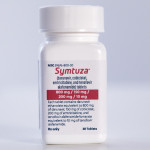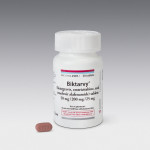An international study comparing Norvir (ritonavir)-boosted Prezista (darunavir) to Kaletra (lopinavir/ritonavir) in people starting treatment for the first time has reported a surprising secondary finding—better virologic control among patients with high pre-therapy viral loads using twice daily, as opposed to once daily, Kaletra. These results, along with those from another study suggesting that Kaletra blood concentrations fall to dangerously low levels in a sizeable percentage of people taking Kaletra once a day, were presented last week at the 11th European AIDS Conference in Madrid (EACS).
In the first study, Nathan Clumeck, MD, of the department of infectious diseases at the Centre Hosptialiere Universitaire Saint Pierre in Brussels, Belgium, presented an analysis of data from the ARTEMIS trial, comparing once-daily boosted Prezista to Kaletra, taken either once daily or twice daily, in people who’ve never taken HIV treatment before.
ARTEMIS randomized 689 patients to receive either boosted Prezista or Kaletra. Of the 319 people in the Kaletra group, 267 (77 percent) took it twice daily and 52 (15 percent) took it once daily. Almost all of the once-daily Kaletra takers were in the United States, the only country to approve both once- and twice-daily dosing for patients starting therapy for the first time.
The original report from ARTEMIS, presented at the 47th Interscience Conference on Antimicrobial Agents and Chemotherapy last month in Chicago, concluded that a similar number of people taking boosted Prezista, compared with those taking Kaletra, had undetectable viral loads after 48 weeks of treatment. However, the authors also reported that patients with high viral loads—in excess of 100,000 copies—were more likely to have viral loads below 50 copies if they were on boosted Prezista than Kaletra.
At the EACS, Dr. Clumeck presented a new analysis of that data, specifically looking at the treatment response of people taking once-daily Kaletra compared with those taking it twice a day. Among those who started treatment with a viral load below 100,000 copies, 71 percent of patients in the once-daily Kaletra group, compared with 81 percent taking twice-daily Kaletra and 84 percent of those taking Prezista, had viral loads below 50 copies after 48 weeks. However, these differences were not statistically significant, meaning they could have been due to chance.
The results were more striking—and statistically significant—when comparing virologic responses among those who started therapy with viral loads in excess of 100,000 copies. In the boosted Prezista group and the twice-daily Kaletra group, 79 and 71 percent had viral loads below 50 copies after 48 weeks, respectively. In the once-daily Kaletra group, only 56 percent of those with pre-treatment viral loads higher than 100,000 copies were undetectable after 48 weeks.
Questions asked by audience members after the presentation suggest that these results need to be interpreted with caution. First, the ARTEMIS study was not originally designed to compare once- versus twice-daily Kaletra. Second, the numbers are likely too small to draw strong conclusions. Only 18 people who took Kaletra once a day started treatment with a viral load greater than 100,000, compared with 92 who took it twice a day and 117 who took Prezista.
Also, it was up to the study investigator to decide on the dosing of Kaletra for each patient. This means that there may have been reasons, such as suspicions of poor adherence, which resulted in a person being prescribed once-daily, instead of twice-daily, Kaletra. Unless dosing is selected using randomization, and both study investigators and patients are blinded to the selection, data can be difficult to interpret.
A second report, presented by Marta Boffito, MD, of the St. Stephen’s Centre in London, and her colleagues, lends further credibility to the data presented by Dr. Clumeck. The study looked at drug levels in the blood of people taking Kaletra once daily or twice daily, or Norvir-boosted Reyataz (atazanavir).
Dr. Boffito’s team enrolled 16 HIV-negative participants who received either 300 mg of Reyataz plus 100 mg of Norvir once a day, once daily Kaletra (800 mg lopinavir plus 200 mg ritonavir) or twice daily Kaletra (400mg lopinavir plus 100mg ritonavir) for 10 days. Blood concentrations of the protease inhibitors were measured regularly for 72 hours following day 10.
They found that 24 hours after the last dose, none of the participants taking boosted Reyataz had blood levels below the minimum effective concentration (MEC) required to keep virus suppressed. However, 44 percent of those taking Kaletra once daily had drug concentrations below the necessary MEC—suggesting that once-daily Kaletra may not be suitable for some HIV-positive people.
While further studies are needed to verify the results of these two trials, they do suggest that once-daily Kaletra may not be an ideal dosing option, especially for HIV-positive people with high pre-treatment viral loads.
Source:
Clumeck N, Van Lunzen J, Chiliade P, et al. ARTEMIS – Efficacy and Safety of Lopinavir (BID vs QD) and Darunavir (QD) in Antiretroviral-Naive Patients [Abstract LBPS7/5] 11th European AIDS Conference, Madrid, 2007.
Boffito M, Else L, Back D, et al. Pharmacokinetics (PK) of Atazanavir/Ritonavir (ATV/r) Once Daily (OD) and Lopinavir/Ritonavir (LPV/r) Twice Daily (BD) and OD Over 72 Hours Following Drug Intake Cessation [Abstract LBPS7/4] 11th European AIDS Conference, Madrid, 2007.






Comments
Comments